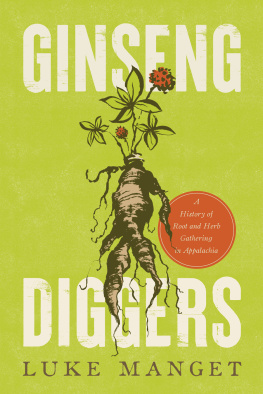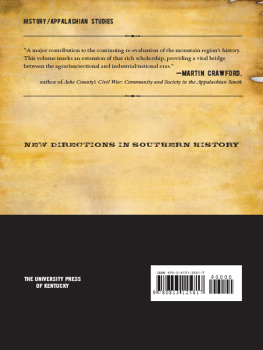GINSENG DIGGERS

Copyright 2022 by The University Press of Kentucky
Scholarly publisher for the Commonwealth, serving Bellarmine University, Berea College, Centre College of Kentucky, Eastern Kentucky University, The Filson Historical Society, Georgetown College, Kentucky Historical Society, Kentucky State University, Morehead State University, Murray State University, Northern Kentucky University, Spalding University, Transylvania University, University of Kentucky, University of Louisville, and Western Kentucky University.
All rights reserved.
Editorial and Sales Offices: The University Press of Kentucky
663 South Limestone Street, Lexington, Kentucky 40508-4008
www.kentuckypress.com
Cataloging-in-Publication data available from the Library of Congress
ISBN 978-0-8131-8381-7 (hardcover : alk. paper)
ISBN 978-0-8131-8382-4 (pdf)
ISBN 978-0-8131-8383-1 (epub)
This book is printed on acid-free paper meeting the requirements of the American National Standard for Permanence in Paper for Printed Library Materials.

Manufactured in the United States of America.
 Member of the Association of University Presses
Member of the Association of University Presses
To my grandmother, Orbenia Greer Stewart Burges,
who grew up digging roots and gathering herbs
in the mountains of eastern Kentucky
and who first stimulated my interest
in the botanical drug trade.
Contents
Introduction
From Roots and Herbs to Crude Botanical Drugs
In locating her laboratories in different parts of the world, nature selected, as one of them, a vast wilderness in the mountainous region which one day was to be the southeastern United States. Here, in what is now southern Virginia and North Carolina, there gradually developed through the ages a wonderful flora, influenced by the tropics on one side and the bracing climate to the northward, of which perhaps some six hundred or more species have had medicinal application. Out of this Blue Ridge section of the Southern Appalachian System now comes 75 per cent of North Americas contribution to the drug supplies of the world.
Henry C. Fuller, The Story of Drugs, 1922.
H ENRY W EBB SCANNED THE GROUND FOR PLANTS AMONG THE forested mountainsides surrounding the picturesque hamlet of Valle Crucis on the Watauga River. It was 1873 and, as in every other spring, the forest floor of this spot in northwestern North Carolina was decorated in a colorful carpet of wildflowers and herbaceous plants. Trilliums, trout lilies, Solomons seal, blue cohosh, black cohosh, and dozens of other plants grew in the shade of Fraser magnolias, chestnuts, striped maples, sugar maples, beech, buckeye, and basswood trees. Webb may not have known every species of mountain flora, but he knew the ones that brought good prices at Henry Taylors store down in the valley. The ultimate prize was ginseng, but it was becoming harder to find, so he settled for the lower-valued mayapple, bloodroot, angelica, and jack-in-the-pulpit, which everyone referred to as Indian turnip. It may not have been much, but it was all the store purchases he made from Taylor during that time.
At his store in Valle Crucis, Henry Taylor collected a variety of roots and herbs from customers like Webb. He had done so for more than two decades. At least once every fall, Uncle Henry, as he was affectionately called by the people of the valley, loaded up a wagon with his peculiar produce and hauled it down the mountain to sell. Before the war, he took his roots to a store near Wilkesboro owned by Calvin Cowles, exchanging them for goods that he hauled back up the mountain to sell in his own store. After the war, he started taking his roots and herbs to George W. F. Harper in the Piedmont town of Lenoir. Although it was not his entire source of revenue, the trade in native medicinal plants helped Taylor weather the postCivil War depression when cash was scarce. In 1883, he opened a new store with a new partner, W. W. Mast, operating it until he died in 1899. In 1913, Mast purchased Taylors interest, and the store became known as Mast General Store. There are now ten Mast General Stores scattered around the southern mountains.
George W. F. Harper, a veteran of the Confederate Fifty-Eighth North Carolina Infantry, returned from the Civil War to revive his fathers store in Lenoir. Domestic demand for roots and herbs had grown since the war, and Harper eyed profits in purchasing roots and herbs from storekeepers like Taylor and selling them to wholesalers in New York, Boston, St. Louis, and Cincinnati who would, in turn, sell them to druggists, patent medicine makers, and pharmaceutical manufacturers. The roots and herbs that Harper and his competitors obtained from rural Appalachians eventually made their way into drugstores, physicians offices, traveling medicine shows, and ultimately human bodies across the United States. As these roots, leaves, berries, flowers, barks, and seeds were abstracted from their mountain environment and entered the webs of exchange that scattered them to distant markets, they became known as crude botanical drugs, or sometimes just crude botanicals.
Harper found an eager buyer for his crude botanicals in Boston wholesaler Gardner S. Cheney. A mason in Boston before the war, Cheney had enlisted in a Massachusetts artillery company five days after President Lincolns call for troops on 15 April 1861, and crossed Burnsides Bridge at Antietam. After the war, he jumped with both feet into the wholesale drug trade, forging a partnership with a former Harvard Shaker named Elisha Myrick to form Cheney and Myrick. Despite their divergent allegiances during the war, Cheney and the ex-Confederate Harper found common cause in the botanical drug trade. From 1867 to 1869, Cheney purchased nearly $10,000 worth of crude botanicals from Harper, far more than any other buyer. In the summer of 1869, the two spent a week botanizing and trout fishing in the Watauga Valley.
Webb, Taylor, Harper, and Cheney formed one of many supply chains established in the wake of the Civil War that would turn the Southern Appalachian bioregion into the United States largest supplier of medicinal plants to global markets. Stimulated by the Civil War and its aftermath, the pharmaceutical industry in the United States entered a period of rapid expansion and consolidation, and demand for crude botanicals skyrocketed. Consequently, between 1865 and 1900, root digging and herb gathering became a general occupation in some mountain communities. One observer claimed that more than forty thousand people gathered roots and herbs for one wholesale herb dealer in Western North Carolina alone during the height of the botanical drug boom in the 1880s. Unmatched before or since, this botanical drug boom left a lasting impression on Appalachian communities.
On a basic level, this is a story about humans, plants, and mountains. While scholars have long known that Appalachian people engaged in root digging and herb gathering, this is the first monograph dedicated to the topic.medicinal plants to explain how and why the region became so integral to the trade. Re-creating the ecologies of root digging and herb gathering, it explores how the trade functioned on the ground, how that experience changed over time, and how the burgeoning commercial relationship influenced the regions land use, social relations, culture, economy, and ecology. While the trade involved hundreds of different kinds of plants, this book focuses primarily on a select handful of the most commonly traded, including mayapple (






 Member of the Association of University Presses
Member of the Association of University Presses